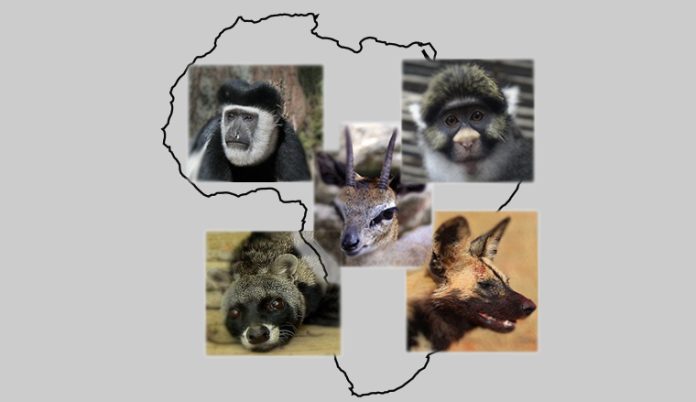Continents across the globe are replete with a vast variety of flora and fauna, which are endemic to these different geographical locations. Africa is no exception as it’s filled with a fascinating array of rich plant and animal species. Let’s take a look at some of these fascinating animals.
The African Civet

The African Civet is a large species of Civet which is found in sub-saharan Africa, they are commonly seen in tropical forests and jungles and areas with dense vegetation to provide both shelter and food for it; its diet is known to include reptiles, insects, fruits and birds.
The African Civet is said to be the largest civet-like animal weighing between 3-10 pounds with the females being a bit bigger than the males. The Civet can live for up to 12years, however they live for much longer in captivity and can almost double that length of time.
The African Civet despite having a cat-like appearance and behaviour is not a feline at all but is in fact, more closely related to other small carnivores like Weasels and Mongoose.
The animal is also well known for the musk called Civetone which it secrets to mark it’s territory. This musk from the Civet has been used in the manufacturing of perfumes for many centuries.
The African Civet stands out distinctively from other species of Civet due to it’s unique black and white markings.
Sclater’s Guenon

The Sclater’s Guenon also called Sclater’s monkey or Nigerian monkey is an arboreal and diurnal primate which lives in the forest of Southern Nigeria. The Nigerian monkey is also known to be a frugivore that supplements its diet with other plants and insects.
The Nigerian monkey was thought to be nearly extinct until the late 1980s. The species is now known to occur in several isolated populations between Niger and Cross Rivers in southern Nigeria which falls in the lower Guinea forest.
The Sclater’s monkey is protected by the local people for its perceived sacred status. The Sclater’s guenon has also been listed as a vulnerable species due to hunting, habitat fragmentation and loss.
African Wild Dog

The African wild dogs are social animals who live in packs usually dominated by a monogamous breeding pair. The long legged canies were once found throughout the continent – from deserts to mountain habitats- they have however disappeared from most of their geographic range. These days they typically roam open plains and sparse woodlands of sub-Saharan Africa. Their largest population are found in Botswana, Zimbabwe, Tanzania and Mozambique.
It’s scientific name Lycaon pictus which means “painted wolf” refers to the irregular, spotted coat of red, black, brown, white, and yellow fur. Each animal has it’s own distinctive speckled coat pattern and all have big, round ears. They are also known as Cape hunting dog or painted dog.
The Cape hunting dog hunt in a formidable pack of six to twenty animals who hunt antelopes and also cooperatively tackle much larger prey like wildebeest. They also supplement their diets with rodents and birds.
The African wild dog is unfortunately the most endangered species, they are often hunted and killed by farmers in order to protect their livestock which the wild dogs sometimes have an appetite for. Added to that, they are threatened by shrinking space to roam, they are also susceptible to diseases like rabies and canine distemper.
Klispringer Antelope

The klispringer is a small sturdy antelope found in Eastern and Southern Africa. It yellowish gray to reddish brown coat acts as a camouflage for it in its rocky habitat. The antelope is mostly monogamous in nature, unlike other antelopes, klispringers exhibit long-term to lifelong pair bonding.
It inhabits places characterised by rocky terrains and sparse vegetation.
There are no major threats to the klispringer because its habitat is inaccessible and unfavourable for hunting. They are herbivous and prefer to eat young plants, fruits, and flowers. Grasses are mostly eaten in the wet season. Klispringers don’t need to drink water often, they rather depend on succulent plants which help them meet their water requirements.
Mantled Guereza

The beautiful mantled guereza is among the most attractive African monkeys. They are also known as black and white colobus, they have glossy, black and white fur and an impressively long tail. These animals live in small groups of about 3-15 monkeys.
The black and white colobus spends most of it’s time in the tree and is mainly active during the day during which time it sources for food.
The monkeys possess multi-chambered stomach with specialised bacteria that helps the monkey digest large amounts of food.
Their diet consists mostly of leaves, seeds, fruits, and insects.
















